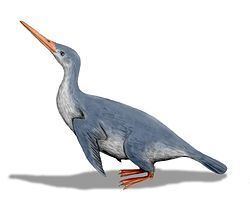Order Sphenisciformes Rank Genus | Class Aves Phylum Chordata | |
 | ||
Similar Anthropornis, Icadyptes salasi, Pachydyptes, Palaeeudyptes, Archaeospheniscus | ||
Hiking to waimanu
Waimanu is a genus of early penguin which lived during the Early Paleocene soon after the Cretaceous–Paleogene extinction event. Its discovery helped support the idea that the radiation of the Neoaves (including most modern birds) either took place before the extinction of the non-avian dinosaurs or extremely rapidly immediately after. DNA-studies seem to indicate the latter. While it was a very early member of the sphenisciformes (the order that included modern Penguins), Waimanu was already flightless like all modern penguins, with wings specialized for wing-propelled diving, though its wing bones do not yet show the extreme specializations modern penguins have for an aquatic lifestyle. It may have resembled a flightless loon in body shape, and possibly the great auk in its manner of locomotion. Both DNA sequence analyses and anatomy argue for a close relationship between penguins and loons, with penguins being specialized for wing-propelled diving, and loons for foot-propelled diving.
Contents
Discovered in the Kokoamu Greensand near the Waipara River, in Canterbury, New Zealand, in 1980, the name Waimanu comes from Māori for "waterbird". Two species are known, Waimanu manneringi from the Middle Paleocene about 60 million years ago (mya) and Waimanu tuatahi from the Late Paleocene, perhaps 58 mya.
